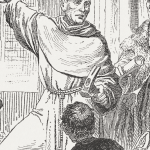Land of the Bible: Nazareth and more
This series with Dr. Varner takes a closer look at the mesmerizing sites located along the picturesque Mediterranean coast, as well as the city of Megiddo, the scenic Jezreel Valley, and the beautiful Lower Galilee.
Ep. 1 Caesarea Part 1
There were two “Caesareas” in Israel. This one, built on an old port called “Strato’s Tower,” is sometimes called Caesarea Maritima to distinguish it from Caesarea Philippi (Baneas) north of the Sea of Galilee which was built by Herod’s Son, Philip. The Caesarea here was built by Herod the Great and later served as the capital of Judea and Palestine for the next 700 years.
Here Cornelius summoned Peter from Joppa to tell him about the Gospel (Acts 10). Here Paul was imprisoned for three years (Acts 23-26). Here the Church fathers Origen and Eusebius did their scholarly work.
Here Cornelius summoned Peter from Joppa to tell him about the Gospel (Acts 10). Here Paul was imprisoned for three years (Acts 23-26). Here the Church fathers Origen and Eusebius did their scholarly work.
Ep. 2 Caesarea Part 2
The theater in Caesarea, which has a seating capacity of over 3000, is still used today for performances. It is worth noting that the "Pontius Pilate" stone was discovered in secondary use in the theater. Additionally, we will review the incident in Acts 12 about the death of Herod Agrippa, which was also described by Josephus. Lastly, it is important to mention that the three styles of capitals - Ionic, Doric, and Corinthian - can be found in the theater.
Ep. 3 Caesarea Part 3
Herod’s palace, located near the Old City of Jerusalem, was one of the grandest and most impressive structures in the region during its time. It served as the seat of the praetorium, the headquarters of the Roman governor, and was also the site of many significant events in biblical history, including Paul's imprisonment and defense before Agrippa (Acts 26). In addition, nearby, you can find the hippodrome on the beach, which was a popular entertainment venue in ancient times, as well as the Mithraeum.
Ep. 4 Caesarea Part 4
The Byzantine shops with a NT inscription in the mosaic floors of what was probably a financial public office. Romans 13:3: “Do you want to be free from fear of the one in authority? Then do what is right and you will be commended.” The view of the great harbor is now within the walls of the Crusader city. The last visit is to the great aqueduct that brought water into the city.
Ep. 5 Har Carmel Part 1
Mt Carmel is technically a ridge rather than a mountain, and it boasts a number of "peaks," one of which is known in Arabic as the "Mukraka" or "burning." The Druze, a unique religious group, have established three towns on Mt Carmel as their homes.
Ep. 6 Har Carmel Part 2
From this vantage point a great view of the valley of Jezreel is enjoyed. Jokneam is the ancient town below, which guarded the pass by the same name.
This is as good a place as any for the dramatic incidents in 1 Kings 18. There is a natural theater, a perpetual spring in the nearby trees, and the Yarkon River still flowing below.
This is as good a place as any for the dramatic incidents in 1 Kings 18. There is a natural theater, a perpetual spring in the nearby trees, and the Yarkon River still flowing below.
Ep. 7 2nd Temple Tomb
The 2nd Temple Tomb, which is located near Megiddo, was accidentally discovered during excavation for a modern road. This tomb dates back to the 1st century AD and is notable for its rolling stone feature.
Ep. 8 Tel Megiddo Part 1
Megiddo guards one of the three famous passes through the Carmel Ridge. The international road is called the Via Maris, the way of the sea. A Roman camp, called Legio, was nearby.
Here King Josiah met his end (2 Kings 35:20-24), and many a battle has been fought here, from Pharaoh Thutmose to Napoleon to General Allenby in the Great War (1918).
Here King Josiah met his end (2 Kings 35:20-24), and many a battle has been fought here, from Pharaoh Thutmose to Napoleon to General Allenby in the Great War (1918).
Ep. 9 Tel Megiddo Part 2
There are several fascinating features to take note of in this video. First, there are two gates: the Canaanite and Solomonic. Next, you'll come across a round Canaanite altar with steps leading up to it, as well as a public grain silo and stables. Perhaps most impressive of all is the great tunnel, which has been dug down to the water source and brought under the walls from a nearby spring. Interestingly, this same water feature can be found in the cities of Hazor and Gezer, as well as Jerusalem.
Ep. 10 Tel Jezreel Part 1
A lone sentinel in the southern part of the valley of Jezreel, this was the site of the palace of King Ahab and the tragic story of Naboth and his vineyard (1 Kings 21).
Ep. 11 Tel Jezreel Part 2
From Jezreel we look across the valley to the north at the foot of the Hill of Moreh, where the Philistines camped before the fateful battle with Saul and Jonathan (1 Samuel 28, 30-31).
Across the valley is the village of Shunem where Elisha raised the woman’s only son (2 Kings 4). Here at Jezreel, Jehu drove furiously and executed the wicked Jezebel (2 Kings 9).
Across the valley is the village of Shunem where Elisha raised the woman’s only son (2 Kings 4). Here at Jezreel, Jehu drove furiously and executed the wicked Jezebel (2 Kings 9).
Ep. 12 Nazareth Part 1
Although we don't visit old Nazareth with its Church of the Annunciation, we see how it was in a hollow between two ridges. Just north of Nazareth was Sepphoris and just south was the great Via Maris.
Ep. 13 Nazareth Part 2
While not the “precipice” of Luke 4, this ridge provides a panoramic view of the Jezreel Valley, the Hill of Moreh, and Mt Tabor. We review the great battle of Barak and Sisera (Judges 4-5) as well as the visit of Saul to the Woman of Endor (1 Samuel 28), and finally the miracle of the dead son in the little village of Nain (Luke 7).
Ep. 14 Basilica of the Transfiguration
The Basilica is the traditional place for the Transfiguration (Matt 17) but most of us opt for a site closer to Caesarea Philippi in the North. The beautiful Basilica has chapels dedicated to the two OT worthies who appeared with Jesus, Moses and Elijah.
Ep. 15 Sepphoris Part 1
Herod Antipas’ capital of the Lower Galilee, Tzippori in Hebrew for “sparrow,” was a center of Hellenistic culture built in the first decades of the first century AD. The ruined theater, original larger than Caesarea’s, was a fixture in a Greco-Roman city like Sepphoris.
The Citadel at the top looms over the Jewish Quarter of 2nd-3rd century city. From it you can get a vista of the Bet Netofa Valley and Nazareth Ridge to the south.
The Citadel at the top looms over the Jewish Quarter of 2nd-3rd century city. From it you can get a vista of the Bet Netofa Valley and Nazareth Ridge to the south.
Ep. 16 Sepphoris Part 2
The text describes a mansion that features a well-preserved mosaic floor. The mosaic is an illustration of a triclinium table where servants used to bring meals to the family. Among the mosaic panels, there is a portrait of the lady of the house (or Aphrodite), which is a relief from the intensive array of panels portraying a contest between Dionysus and Hercules for who could drink the most.
Additionally, the lower city has a Cardo and a Decumanus, which are the two main cross streets of every Roman city. The city also boasts several colorful mosaics, the most famous of which depicts the measuring of the Nile, and another one displaying ancient Amazons.
Additionally, the lower city has a Cardo and a Decumanus, which are the two main cross streets of every Roman city. The city also boasts several colorful mosaics, the most famous of which depicts the measuring of the Nile, and another one displaying ancient Amazons.
Ep. 17 Lower Galilee
The view from Mt Arbel of the Lower Galilee, along with Isaiah 9:1-2 and Matthew 4, provide a view of Zebulon and Naphtali, the Via Maris, and the Sea of Galilee including Magdala and Capernaum. The caves were famous during the young Herod’s days as well as for hideouts for later bandit types.



